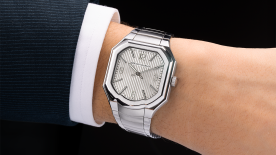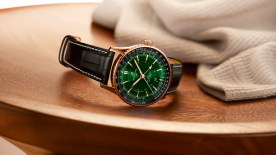There are people out there who are super passionate about watches. You’re thinking, this woman is the editor-in-chief of a watch website and she’s telling us that people care deeply about watches? Isn’t that the entire reason that a site like this exists? Yes, I hear you; I know very well that for every area of interest out there, whether it be watches or home baking or high fashion or knitting, there will be communities of devoted enthusiasts around it. What I’m saying is that watch lovers can exhibit levels of passion rivalling the ardour that most people reserve only for cherished cultural touchstones (witness the vitriol poured out upon Jamie Oliver a few years ago when he had the audacity to suggest putting chorizo in paella) or sporting team rivalries.
As a journalist, I’ve been trained to see both sides of the debate, to have my own informed opinion but still be able to recognise the validity of an equally informed opposing point of view. The keyword here is “informed”. You can believe what you want; you can think what you want. But you shouldn’t feel entitled to shove your opinions onto others unless you can back them up with facts and well-reasoned logic. I think that’s only fair. What do you do, then, when the subject of debate is predicated entirely on subjective criteria? I refer, of course, to the Iconic category of watches competing in the Grand Prix d’Horlogerie de Genève (GPHG).

I was lunching the other day with a friend who also works in the watch industry, and the conversation got heated over coffee, while we were talking about the finalists in the Iconic category of watches in this year’s edition of the GPHG. He didn’t understand the inclusion of the Girard-Perregaux Casquette in this category and was resisting (with unexpected energy) my efforts to illuminate him. I could have spent the whole afternoon trying to convince him and it wouldn’t have made any difference; he had never heard of the Casquette before this year, the Casquette was not an iconic watch in his personal horological Weltanschauung, and that was that. Happily (hopefully), the GPHG jury this year is filled by people who are better able to separate subjective experience from objective assessment.
It goes without saying that the Casquette is iconic. It is part of a long tradition of watches with alternative orientations of time displays, part of the horological milieu known as drivers’ watches (other illustrious examples being the Vacheron Constantin 1921 and the vintage Patek Philippe ref. 576). As the mid-1970s hit, the new generation of drivers’ watches began to make their presence felt, with timepieces such the Bulova Computron, Amida Digitrend, Mido Swissonic — and yes — the Girard-Perregaux Casquette all taking the stage around the same time.

The Casquette was not made in enormous quantities, certainly not in context of what we’re used to nowadays, but a total production run of between 8,000–8,500 from 1976 to 1978 is pretty substantial, especially for an unusual design like this. It was even more notable by the fact that it was produced in gold (and not merely gold-plated), with a quartz movement. At the time, the advent of quartz movements was still roundly blamed for the abject plunge in the market for mechanical watches, but quartz movements were not denigrated as being “cheap” or dismissed as low-quality in the same way that mechanical purists do today. They were seen as representing the forefront of timekeeping technology.
Even before this year’s relaunch, the Girard-Perregaux Casquette continued to burn strongly in the hearts of watch aficionados all over the world, and the Casquette 2.0 is well positioned to endear itself to new collectors and enthusiasts in 2022.

So much for the watch itself — although I never thought I’d actually have to argue for the significance of the Girard-Perregaux Casquette to anyone who claims to be a watch lover. But is it significant to the point of being an icon? This is where the judging criteria is super important. The GPHG rules state that watches competing in this category must come “from an emblematic collection that has exercised a lasting influence on watchmaking history and the watch market for more than 20 years.”
First of all, I don’t think a lot of people are all that familiar with the rules. I could buy you a drink for every single person you find on the GPHG Jury (and even in the Academy) who knows the rules, and you would still be more or less sober at the end of it. Second of all, the rubric itself is wide open to interpretation. How do you define “emblematic” or “lasting influence”? This is where the real battleground will be when the GPHG Jury comes to the Iconic category during their final deliberations next month.
If you ask me, there’s no question that the Girard-Perregaux Casquette has earned its place in this category. It captured imaginations when it was released, and is an ideal example of the horology of its time. It held its appeal over the decades. It continues to inspire watchmaking today — Max Büsser, whose impact on modern independent watchmaking cannot be disputed, has acknowledged the influence of the Casquette and other 1970s drivers’ watches on some of his key creations. If you don’t think that’s an icon, I’m happy to hear your rebuttal. (Sips coffee.)







